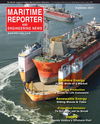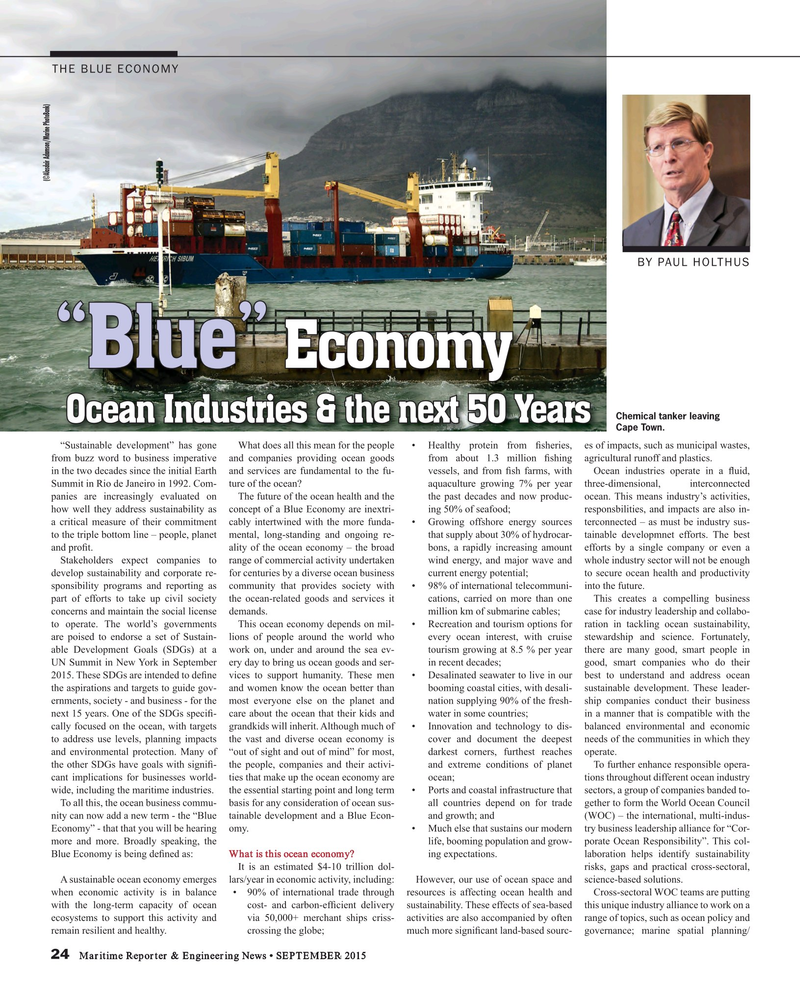
Page 24: of Maritime Reporter Magazine (September 2015)
Offshore Energy Technologies
Read this page in Pdf, Flash or Html5 edition of September 2015 Maritime Reporter Magazine
THE BLUE ECONOMY (©Alasdair Adamson/Marine PhotoBank)
BY PAUL HOLTHUS “Blue”“Blue” EconomyEconomy
Chemical tanker leaving
Ocean Industries & the next 50 YearsOcean Industries & the next 50 Years
Cape Town. “Sustainable development” has gone What does all this mean for the people • Healthy protein from ? sheries, es of impacts, such as municipal wastes, from buzz word to business imperative and companies providing ocean goods from about 1.3 million ? shing agricultural runoff and plastics. in the two decades since the initial Earth and services are fundamental to the fu- vessels, and from ? sh farms, with Ocean industries operate in a ? uid,
Summit in Rio de Janeiro in 1992. Com- ture of the ocean? aquaculture growing 7% per year three-dimensional, interconnected panies are increasingly evaluated on The future of the ocean health and the the past decades and now produc- ocean. This means industry’s activities, how well they address sustainability as concept of a Blue Economy are inextri- ing 50% of seafood; responsbilities, and impacts are also in- a critical measure of their commitment cably intertwined with the more funda- • Growing offshore energy sources terconnected – as must be industry sus- to the triple bottom line – people, planet mental, long-standing and ongoing re- that supply about 30% of hydrocar- tainable developmnet efforts. The best and pro? t. ality of the ocean economy – the broad bons, a rapidly increasing amount efforts by a single company or even a
Stakeholders expect companies to range of commercial activity undertaken wind energy, and major wave and whole industry sector will not be enough develop sustainability and corporate re- for centuries by a diverse ocean business current energy potential; to secure ocean health and productivity sponsibility programs and reporting as community that provides society with • 98% of international telecommuni- into the future.
part of efforts to take up civil society the ocean-related goods and services it cations, carried on more than one This creates a compelling business concerns and maintain the social license demands. million km of submarine cables; case for industry leadership and collabo- to operate. The world’s governments This ocean economy depends on mil- • Recreation and tourism options for ration in tackling ocean sustainability, are poised to endorse a set of Sustain- lions of people around the world who every ocean interest, with cruise stewardship and science. Fortunately, able Development Goals (SDGs) at a work on, under and around the sea ev- tourism growing at 8.5 % per year there are many good, smart people in
UN Summit in New York in September ery day to bring us ocean goods and ser- in recent decades; good, smart companies who do their 2015. These SDGs are intended to de? ne vices to support humanity. These men • Desalinated seawater to live in our best to understand and address ocean the aspirations and targets to guide gov- and women know the ocean better than booming coastal cities, with desali- sustainable development. These leader- ernments, society - and business - for the most everyone else on the planet and nation supplying 90% of the fresh- ship companies conduct their business next 15 years. One of the SDGs speci? - care about the ocean that their kids and water in some countries; in a manner that is compatible with the cally focused on the ocean, with targets grandkids will inherit. Although much of • Innovation and technology to dis- balanced environmental and economic to address use levels, planning impacts the vast and diverse ocean economy is cover and document the deepest needs of the communities in which they and environmental protection. Many of “out of sight and out of mind” for most, darkest corners, furthest reaches operate. the other SDGs have goals with signi? - the people, companies and their activi- and extreme conditions of planet To further enhance responsible opera- cant implications for businesses world- ties that make up the ocean economy are ocean; tions throughout different ocean industry wide, including the maritime industries. the essential starting point and long term • Ports and coastal infrastructure that sectors, a group of companies banded to-
To all this, the ocean business commu- basis for any consideration of ocean sus- all countries depend on for trade gether to form the World Ocean Council nity can now add a new term - the “Blue tainable development and a Blue Econ- and growth; and (WOC) – the international, multi-indus-
Economy” - that that you will be hearing omy. • Much else that sustains our modern try business leadership alliance for “Cor- more and more. Broadly speaking, the life, booming population and grow- porate Ocean Responsibility”. This col-
Blue Economy is being de? ned as: What is this ocean economy? ing expectations. laboration helps identify sustainability
It is an estimated $4-10 trillion dol- risks, gaps and practical cross-sectoral,
A sustainable ocean economy emerges lars/year in economic activity, including: However, our use of ocean space and science-based solutions. when economic activity is in balance • 90% of international trade through resources is affecting ocean health and Cross-sectoral WOC teams are putting with the long-term capacity of ocean cost- and carbon-ef? cient delivery sustainability. These effects of sea-based this unique industry alliance to work on a ecosystems to support this activity and via 50,000+ merchant ships criss- activities are also accompanied by often range of topics, such as ocean policy and remain resilient and healthy. crossing the globe; much more signi? cant land-based sourc- governance; marine spatial planning/ 24 Maritime Reporter & Engineering News • SEPTEMBER 2015
MR #9 (18-25).indd 24 MR #9 (18-25).indd 24 9/3/2015 10:47:34 AM9/3/2015 10:47:34 AM

 23
23

 25
25
